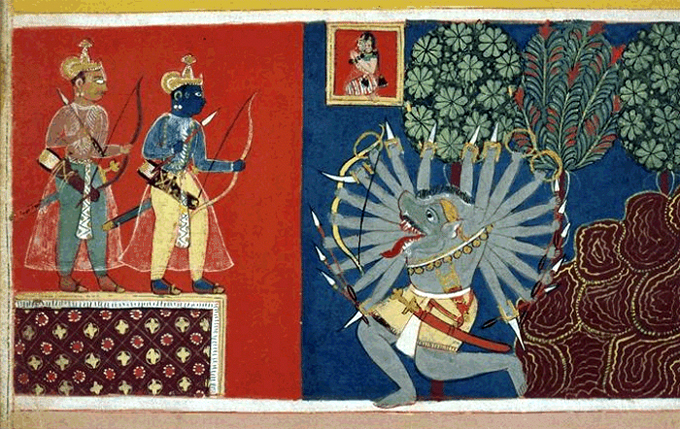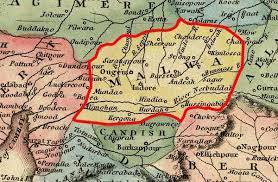
Ramayana – Malwa, 1640 A.D.
Among the most important Miniature paintings to be produced by the Malwa School in the 17th Century are those illustrating a Rasikapriya manuscript from 1634 A.D., a series from the Amaru Sataka painted in 1652 A.D. in Nasratgarh, and a Ragamala series produced in 1680 A.D. at Narsyanga Shah. The Malwa School of painting existed for a relatively short period of time, ending around the end of the 17th Century.
Typical characteristics of Malwa School paintings are the refined drawing styles and use of boldly contrasting colours, and as previously mentioned, the use of compartmentalized scenes. A significant Mughal influence is present in both ornaments and costumes, which sometimes feature black tassels and striped skirts not found in indigenous Central India paintings of the period.
In the Ramayana illustration above, we have an example of all these characteristics. Rama and Laksmana are framed separately from the demon Ravana. Sita Devi is shown, in a striped skirt, framed almost like a picture on the wall, although the scene takes place outdoors. All the figures are flat and one-dimensional. In both the patterned pedestal the divine Heroes stand on and in the earth/rocks behind the demon, we have an interesting co-mingling of designs. The patterns seem to be mid-way between Indian and Persian motifs.
Art historians have suggested that the Malwa School does not belong to the geographical region of Malwa, but more likely to the Bundelkhand, on its eastern side. The ancient Malwa kingdom spanned part of western Madhya Pradesh and southeastern Rajasthan, up to the Nimar region, north of the Vindhyas. It has been ruled over the ages by the Avantis, the Mauryans, the Guptas, the Parmaras, the Malwa sultans, the Mughals, the Marathas, and British India.
The culture of Malwa has been significantly influenced by Gujarati and Rajasthani culture, because of their geographic proximity. Marathi influence is also visible, because of recent rule by the Marathas.
The main language of Malwa is Malvi, although Hindi is widely spoken in the cities. This Indo-European language is subclassified as Indo-Aryan. The language is sometimes referred to as Malavi or Ujjaini. Malvi is part of the Rajasthani branch of languages; Nimadi is spoken in the Nimar region of Madhya Pradesh and in Rajasthan. The dialects of Malvi are, in alphabetical order, Bachadi, Bhoyari, Dholewari, Hoshangabadi, Jamral, Katiyai, Malvi Proper, Patvi, Rangari, Rangri and Sondwari. A survey in 2001 found only four dialects: Ujjaini (in the districts of Ujjain, Indore, Dewas and Sehore), Rajawari (Ratlam, Mandsaur and Neemuch), Umadwari (Rajgarh) and Sondhwari (Jhalawar, in Rajasthan). About 55% of the population of Malwa can converse in and about 40% of the population is literate in Hindi, the official language of the Madhya Pradesh state.
Lavani is a widely practised form of folk music in southern Malwa, which was brought to the region by the Marathas. The Nirguni Lavani (philosophical) and the Shringari Lavani (erotic) are the two of the main genres. The Bhils have their own folk songs, which are always accompanied by dance. The folk musical modes of Malwa are of four or five notes, and in rare cases six. The devotional music of the Nirguni cult (which I shared yesterday) is popular throughout Malwa. Legends of Raja Bhoj and Bijori, the Kanjar girl, and the tale of Balabau are popular themes for folk songs. Insertions known as stobha are commonly used in Malwa music; this can occur in four ways: the matra stobha (syllable insertion), varna stobha (letter insertion), shabda stobha (word insertion) and vakya stobha (sentence insertion).



